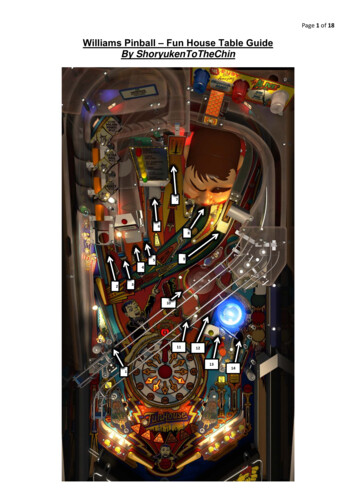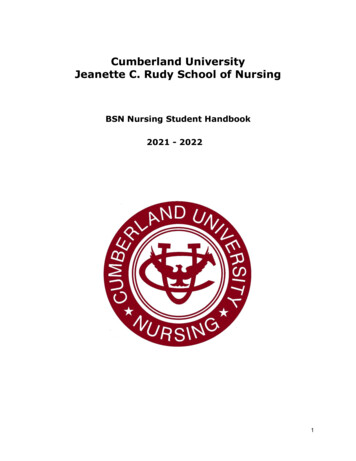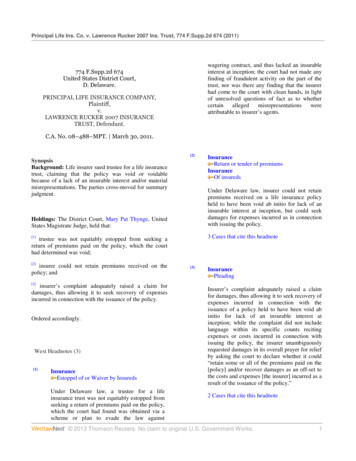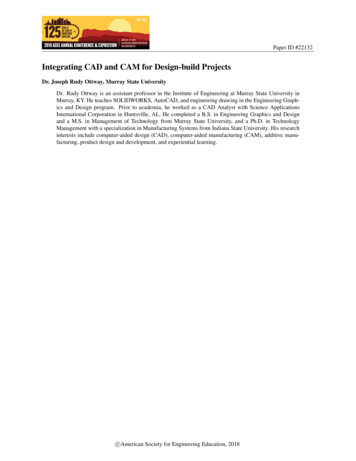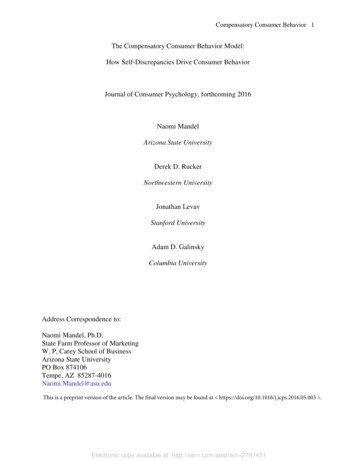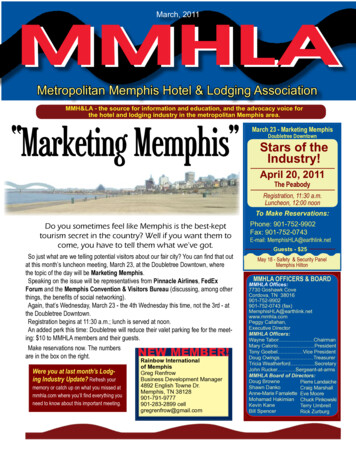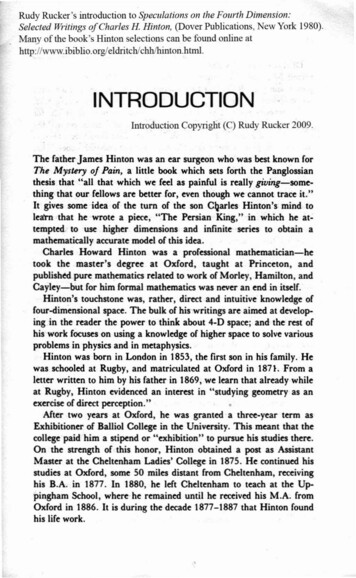
Transcription
Rudy Rucker's introduction to Speculations on the Fourth Dimension:Selected Writings a/Charles H. Hinton, (Dover Publications, New York 1980).Many of the book's Hinton selections can be found online INTRODUCTIONIntroduction Copyright (C) Rudy Rucker 2009.The father James Hinton was an ear surgeon who was best known forThe Mystery of Pain, a little book which sets forth the Panglossianthesis that "all that which we feel as painful is really giving-something that our fellows are better for, even though we cannot trace it."It gives some idea of the tum of the son CQaries Hinton's mind tolea:rn that he wrote a piece, "The Persian King," in which he attempted to use higher dimensions and infinite series to obtain amathematically accurate model of this idea.Charles Howard Hinton was a professional mathematician-hetook the master's degree at Oxford, taught at Princeton, andpublished pure mathematics related to work of Morley, Hamilton, andCayley-but for him formal mathematics was never an end in itself.Hinton's touchstone was, rather, dir«t and intuitive knowledge offour-dimensional space. The bulk of his writings are aimed at developing in the reader the power to think about 4-D space; and the rest ofhis work focuses on using a knowledge of higher space to solve variousproblems in physics and in metaphysics.Hinton was born in London in 1853, the first son in his family. Hewas schooled at Rugby, and matriculated at Oxford in 1871. From aletter written to him by his father in 1869, we learn that already whileat Rugby, Hinton evidenced an interest in "studying geometry as anexercise of dirttt perttption."After two yean at Oxford, he was granted a three-year term asExhibitioner of Balliol College in the University. This meant that thecollege paid him a stipend or "exhibition" to pursue his studies there.On the strength of this honor, Hinton obtained a post as AssistantMaster at the Cheltenham Ladies' College in 1875. He continued hisstudies at Oxford, some 50 miles distant from Cheltenham, receivinghis B.A. in 1877. In 1880, he left Cheltenham to teach at the Uppingham School, where he remained until he received his M.A. fromOxford in 1886. It is during the decade 1877-1887 that Hinton foundhis life work.
viSPECULATIONS ON THE fOURTH DIMENSIONOf this period he writes in A New Era of Thought that, "I foundmyself in respect to knowledge like a man who is in the midst ofplenty and yet who cannot find anything to eat. All around me werethe evidences of knowledge-the arts, the sciences, interesting talk,useful inventions-and yet I myself was profited nothing at all; forsomehow, amidst all this activity, I was left alone, I could get nothingwhich I could know." Desperate for some absolute knowledge, Hintonhit upon the plan of memorizing a cubic yard of one-inch cubes. Thatis, he .took a 36 X 36 X 36 block of cubes, assigned a two-word Latinname (e.g. Collis Nebula) to each of the 46,656 units, and learned touse this network as a sort of "solid paper. Thus when he: wishtd toIIvisualize: somt: solid structure, he would do50by adjusting its size sothat it fit into his cubic yard. Then he could describe the structure bylisting the names of the occupied cells. Hinton maintains that hethereby obtained a sort of direct and sensuous appreciation of space.Given that Hinton's father had been known for his exceptionalmemory, and that there is a system which reduces the brute facts to bememoriz to 216, this learning of a block of one-inch cubes is not inconceivable.JBut now Hinton went on to memorize the positions of thelillie cubes for each of the 24 possible orientations (six choices for thebottom face times four choices for the front face) which the blockt have rtlativc to the observer.is reasons for doing thisar d ribedin his essay "Casting Outthe Self." If cube A is touching cube B, this is an absolute fact. But tosay that cube A is above or behind cube B is simply to say somethingabout the relation of .the self to the arrangement of cubes. It was inorder to eliminate such "self-dements" that Hinton learned the blockof cubes in each of its 24 possible orientations.This casting out of Jr-c:lemenls ltd to an interesting question: Isthe difference tween an arrangement of cubes and the mirror imageof this arrangement absolute or relative? Hinton brooded over Kant'sremarks (in section 13 of the Pro/egom.na) on the question of whetherthe apparently irreconcilable difference between a right hand and aleft hand is not somehow the result or a limited space intuition; and hemay have heard of A. F. Mobius's 1827 discovery that any 3-D objectcan be turned jnto its mirror-image by a rotation through 4-D space.1n.an.y-.c;a Hinton now became interest«l in the rounh dimension.He used his "solid paper" to construct for himself the various cubical cross-sections of the hypercube or tesseract (a word which Hinton mayhave coined himself), assigning a different color to each of the 81 parts
INTRODUCTIONvii1(1 t.seract 8 cubes 24 squar. 32 line segments 16 point.)of the t.ract to keep things .traight. By working with thrsc crosssections he was able to visualize the reality of the fact that if at.seract is pushed through our space, turned over, and pushed backthrough, then the last cubical cross-sectlon sttn will be the mirrorimage of the la.t secn the lirst time through.A. his understanding of the fourth dimension grew. Hinton set towriting about it. His lirst published rssay. "What Is the Fourth Dimension?," appeared in 1880 in tne Dublin Univ rsily MagQZin J wasreprinted in the Cheltenham Ladies' College Magazine of September1883. and linally was published as a pamphlet, with the subtitleGhosts Explained, by Swann Sonnenschein & Co. in 1884. In the period 1884-1886. Swann Sonnenschein published in London nine different such pamphlets by Hinton which were then collected in thewo-volume set, Sci nlif Romances.Swann Sonnenschein was to be the original publisher for all ofHinton's book . Asound 1910. Allen & Unwin obtained the rights tothe books. which they kept in print for a number of years. In the introduction to The Fourth Dimension Hinton acknowledg. hi. debt to"the publisher of this volume. Mr. Sonnenschein, to whose unique appreciation of the line of thought of thi a. of my former .y theirpublication is owing."All but three of the Scientific Romances arc partially reprintedbelow. I have omitted the lengthy "The Persian King," .ubtitled"The Mystery of Plea.ure and Pain," which is about a king whokeeps a valley running by absorbing a small amount of pain fromeveryone, so that there is enough differential between pleasure andpain for activity to exi.t. I have left out "On the Education of theImagination," which is basically an exhortation to memorize largeblock. of cubrs; and I have left out the long novella Stella.This last piece is a lirst-person d SCription of tte narrator'. love affair with a girl who has been made invisible by her guardian. That i.,he has provided her with an elixir which she drinks to make her indexof refraction equal to that of air. This work can be viewed as a veryearly piece of science liction (perhaps providing the inspiration for H.G. Wells's The Invisible Man), but it also has a certain didactic purpose. Hinton shared with his father a very strong conviction that thekey to right living is openness and altruism. As Stella "ys, "Being isbeing for others." The reason Stella chooses to remain invisible is sothat she will not fan into a self-serving concern with her own ap-
viiiSPECULATIONS ON TilE FOURTH DIMENSIO:"ipearance. Hinton clearly was groping ror some higher-dimensional justification or his .hical b lids in Stella, but the time was not y. ripe.The most interesting idea in Slt!lla, that of two-dimensional time, istreated in a more vivid fashion in the stunning tale An UnfinishedCommunication." Two-dimensional time works something like this:First start with the idea or your entire lire as b ing a fixM objtet in4-D spae time, then imagine that while some s cond time lap.s, yourentirt lire gradually tvolv. into. a different one. Hinton rtturns to thistheme in A New Era 01 Thought, where, rath r than sugg.ting asecond time dimension, he employs the nOlion of the eternal returnand speaks or lire as a sort or phonograph r cord which is piaYM ov rand over, undergoing slight alterations each time.R.urning to the Scientific Romances colltetion, we have "A PlaneWorld," a cousin or Abbott's 1884 Flatland, which Hinton rtr rs to ina brid introduction to his essay: "And I should have wished to b ableto rcr r the rtad r ahog.h r to that ingenious work, 'Flatland'. Buton turning ov r its pages again, I find that the author has u.d hisrare talent for a purpose foreign to the intent of our work. For evi·dently the physical conditions or lire on the plane have not been hismain object. He has used them as a setting whaein to platt his satireand his I ssons. But we wish, in the first place, to know the physicalfacts. "A rtally rtmarkable reaturt or the 2-D world d.cribed in "A PlaneWorld" is that it exists on the surfa of a sphere, instead of a plane;and is thus more similar to Dionys Burger's Sphereland than toEdwin A. Abbott's Flatland. The logical step to take art r describingthis 2-D world on a sph re would b to suggest that our 3-D spae isthe hypersurrae or a hypersph re. Bernhard Riemann hintM at thisidea as early as 1854, but it was Einstein who first .riously advocatMit.A Picture of Our Universe" was written as a companion piece to"A Plane World," and h re Hinton mak. a sustainM errort to findsome physical application ror the notion or 4-D spae . Hinton's working hypoth.is, which he prt.ntM as early as the end or "What Is theFourth Dimension?," is that the: matter of our world actually has aslight hyperthickness in the dirtetion or a rourth spatial dimension.In the first part of the essay under discussion, Hinton attempts toexplain static electricity as a twisting of matter in 4-D space. Hecomes remarkably close here to anticipating the modern notion of anti·matt r-as Martin Gardn r has pointM out in Chapter 24 or TheUU-"----- - . ---
INTRODUCTIONixAmbidextrous Universe, which also. contains a reference to theKaluza-Kldn fiv.-dim.nsional th.ory of relativity which in some .n.formaliz.s th. id.a Hinton p.nted h. In a much lat. . .ssay."The Recognition of the Fourth Dimension," Hinton was to present av.ry difT.nt4-0 modding of static .Iectricity.In th. second part of "A Pictu. of Our Univ." Hinton d.scribeshis conception of th. a.th. as a 4-0 hyporsolid upon which th.(hyporthin) 4-0 objects of our space move about. This .p.nts adistinct d.viation from mod.n physical theory. As Hinton says in ANew Era of Thought, uWe will suppose, then, that we are not in, buton the aether, only not on it in any known direction, but that the newdirection is that which comes in. The aether is a smooth body, alongwhich w. slid., being distant from it aty point about the thicknessof an atom." JMy italics.J Now, the question of whether or not ourmatter is ultimately four-dimensional is, to say the least, open. Butthere are now no scientists who would assent to the conception of afixed spatial aether next to our universe.If there is an aether, it is to be conceived of as something which weare in-primarily because only needless complications result if anything 01. is assum.d. Ind.ed, it might not be too much to say thatHinton's beli.f that w. a. not in, but on th. a.th. proved to be th.major stumbling block in his att.mpts to attain a high.- lim.nsionalphysics. It should be point.d out on Hinton's behalf that h. had goodreason for believing that we cannot be in the luminiferous aether. Theconclusion from the obs.rv.d prop.ti.s of light and th. physics of th.tim.emed to be that th. aeth. is solid-and w. cannot v.y wdl bemoving around inside a solid.This whol. puzzk was dissolv.d by th. Special Theory of R.lativityin 1905 with th. abolishing of spac. a.th. in favor of spautimeaether. It is hard, initially, to appreciate the difference. But a curioussugg.stion which Hinton mak.s at the .nd of "A Pictu. of OurUniv.s." (and which h.turns to in An Episode of Flatlancf) . rvesto clarify the issu . Hinton sugg.sts that, "A being abl. to lay hold ofthe a.ther by any means would, unl.ss h. w. instantly lost fromamongst us by his staying still whil. th arth dash.s on-h. would beable to pass in any spa direction in our world. He would not need toclimb by stairs, nor to pass along resting on the ground." In otherwords, if on. only had some 4-0 pitons, th.n on. could climb up theface of th. a.th. to noat a hundred f t above th. ground. But amark. driven into the a.th. would supply an absolut .standard of.v.
xSPECULATIONS ON THE FOURTH DIMENSIONrest-which is ruled impossible by Special Relativity. However, asEinstein pointed out in his essay "Ether and the Theory ofRelativity," th very notion of the spacetime metric tensor's existencein empty spatttime rves to validate the notion of a spacetime aClher.The only selection from ScimtifU Romances I will not discuss atlength is the pit« "Many Dimensions." This is one of the mostinspiring of Hinton's writings. With his usual elegance of style hemoves from the question of UWhy not fi dimensions?" to drawingethical lessons from the existence of 4-0 space.Soon after Hinton r«ieved his master's degree from Oxford in1886, he left his post at Uppingham School to teach for several yearsin the Japanese government middle schools. He left the book A N.wEra of Thought in manuscript form with his friends Alicia Boole andH. John Falk. They used his manuscript, essentially unrevised, forPart 1 of A N.w Era of Thought; and for Part 2 they themselves wroteup a detailed description of the exercises with colored cubes whichHinton had employed to get a mental image of the tesseract.Part 1 consists of a somewhat rambling and disconnected series ofchapters about the possibility of thinking four-dimensionally, andabout the religious and philosophical insights thus obtainable. Thispart bears evidence of not having been reworked by the author; forinstance, Hinton somehow neglects to make a crucial point (that acube can be turnrd into its mirror image by rotation through thefourth dimension) which he spends several chapters leading up to.Nevertheless, this book was written at the high point of Hinton's con·fidence in the fourth dimension as a sort of philosopher's stone forhuman inquiry, and his enthusiasm is infectious.Chapters 7 and 9 of A N.w Era of Thought (the sections entitledu lf Elements in Our Consciousness" and "Another View of th Aether" in th pr nt volum ) are of panicular interest. Som treat·ments of the fourth dimension, for example that of E. H. Neville in hisTh. Fourth Dimmsion, proceed purely analytically, treating 4-0space as nothing but a collection of ordered quadruples of real numbtrs with certain udistance" and Hangl 1I relations d fined amongthese quadruples. Other treatments, for example that of H. P. Manning in his C.om.try of Four Dimmsions, proceed synthetically in themanner of Euclid, stating axioms about 4·0 ntiti s from whichtheorems are then derived. Hinton is one of the very few who has heldto the intuitive and descriptive approach in discussing 4-D space. Inthe section of A N.w Era of Thought entitled "Self Elements in OurConsciousness," he proyid s a v ry ing nious buual to the so--com-
INTRODUCTIONximonly-heard philistinism that it is hope"ss to imagine what th. extraspatial dimension looks like because no one has ever seen it.In Chapter 9 Hinton d.scribts in some ddail his phonographrttord view of th. a.ther. Th. id.a is that the a.ther has grooveswhich control th. bthavior of th. mailer sliding over it. Th. assumption stems to bt that very so oftm th. Earth will slid. back to itsstarting point on th. a.ther, and th.n history will r p at itself. Inorder to make room for fr« will and th. sort of 2-D tim. h. dtseribtsin "An Unfinishtd Communication," Hinton assumes that each timethe eternal return is accomplishtd and we slide over the grooves of ourIif. again, w. are abl. to alter slightly th. dirtetions of th. grooves. H.goes on to draw th. moral that sine w. all have a.ther.al bodieswhich are grooves on th. on. a.ther, then th. mystic t.aching All isOn. is to bt uph ld.Hinton's father James one had his marriage proposal rejteted btcause h. was susp cled of having abandoned Christianity for th.abstract id.al of altruism. (Th. third tim. h. asked th. girl, a MissHaddon, she accepted.) Hinton proves himself a loyal son in this book,written some ten years after the father's death from inflammation ofth. brain in 1875. Ther. is a great d.al in Part 1 about th. id.a thatthe sooner we start thinking of those around us as the same as our-selves, th. sooner w. will bt abl. to .nter into th. higher mysteries.Th. second part of A New Era of Thought consists of a dtseriptionof how to visualize a tesseract by looking at various 3-D cross sectionsof it. On. is to construct a s t of 12 cubts, coloring th. faces, edges andcorners all manner of differ.nt colors. (Eighty-on. differ.nt colors areused, and some rather unfamiliar ones are resorttd to. The modernreader may bt amuS d to not. that th. lin. going into th. fourth dimension relative to the first cube is to be colored "stone. tI) Eight ofth. cubts make up th. boundaries of th. hyptrcubt, and th. fouroth.rs are cross sections tak.n bttw«n pairs of opposite cubts. Th.way in which all th. cubts fit tog.ther is really explained rather w ll,if on. has th. will to .ndure not only 81 colors, but th. 81 Latinnames which Hinton assigns to th. parts of th. tesseract.In addition to th. set of 12 larg. cubts, ther. was also to bt a set of81 small monochrome cubes. each representing a part of the tesseract.By moving thes. lilli. cubts about on. could btlter compreh.nd th.fact that rotation through the fourth dimension corresponds to mirrorimage reflection in 3-D space.Judging from th. quotes which Sonn.nsch.in & Co. reprint on th ndpapers of Hinton's books, both the Scientific Romances and A
xiiSPECULATIONS ON THE fOURTH DI).IENSIONN.w Era'of Thought we" quite favorably received in England. Of theScientific Romance "What Is the Fourth Dimension?," the Pall MallGazelle wrote, Hit is a short treatise of admirable clearness. Mr.Hinton brings us panting, but delighted, to at least a momentary faithin the Fourth Dimension, and upon the eye there opens a vista ofinteresting problems. It exhibits a boldness of speculation and a powerof conceiving and expressing even the inconceivable, which rousesone's faculties like a tonic." The Lit"ary World discussed A N.w Eraof Thought in equally athletic terms, "A theoretical and practicaltreatise on the Fourth Dimension. The book is a powerful mentalgymnastic; the style is as clear as it can be. The author is in grimearnest, and promises a complete system of four-dimensionalthought-Mechanical, Scientific, and Aesthetic."But meanwhile Hinton was in Japan, perhaps at a position wherehe was allowed to drill students in the use of his cubes. Such far-ranging travels were nothing unusual for Hinton's family. His grandfather,a Baptist minister, had been across the Atlantic and was best knownfor his book Th. History and Topography of th. Unit.d StaUs ofAmmca. His father spent some time working on a ship transportingBlacks from Sierra Leone to Jamaica, lived for a while in NewOrleans, and owned property in the Azores, where he died.Exactly how long Hinton stayed in Japan is unclear, but in the Fallof 1893 he started a stint as Instructor in the Mathematics Department of Princeton University. There were only three other teachers inthe department at that time, but Hinton s""ms to have n at the bottom of the pecking order. He taught only Freshman and Sophomorelevel courses-Elementary Solid Geometry and Mensuration,Trigonometry, and Conic Sections, in particular-and he was firedafter four years. In a piece called "The Oxford Spirit" which he wrotefor the lnd",mdmt in 1902, Hinton expressed some bitterness at histreatment by the American educational system. Hln America a newphenomenon has arisen-the business man in control of the halls oflearning. The college president runs his university as if it were a greatfactory. He makes a number of provisional appointments-instructors.The instructors know that during term time they must work to the fullextent of their energy in instruction, and occupy their vacations inprosecuting their subject if they are to retain their positions."It cannot really be said that Hinton followed this formula whileteaching at Princeton. He was friendly with his students and becamevery interested in baseball-so much so that he invented a sort of base-
INTRODUCTIONxiiiball gun. As he wrote in his article A Mechanical Pitcher," inHarp,,', Weekly, March 20, 1897, "The project of constructing amechanical pitcher was suggested to me by considerations all who areinterested in baseball will appreciate. I had remarked the frequent occurence of sore arm" as also that it was only in the matchesthemselves that many a batter had experience of really first class pitching." So, after a period of experimentation, he developed a gun which,when charged with gunpowder, would shoot a baseball at the requisite40 to 70 miles per hour. The speed was adjusted by varying the size ofthe adjustable breech; and, most importantly, any desired curve ordrop ball could be shot by adjusting two rubber- :oated stcelfingers attached to the muzzle of the gun. The Princeton nine worked out withthis mechanical pitcher for several years, although it was eventuallyabandoned because of the fear it inspired in the batters.There is a curious story connected with Hinton's discovery of thebaseball gun which is reported in h'is obituary, which Gelett Burgesscontributed to the New York Sun on May 5, 1907. "Although on account of his enthusiasm for metageometry he was never a great successas an instructor in his college positions, he made many friends, and inPrinceton endeared himself to the students by one of the most successful practical jokes ever perpetrated ther . This was just after hisperfection of the baseball gun. He invited the faculty and students to alecture, at which he demonstrated the machine and described its scientific theory. While he was upon the platform the lecture was interrupted by the arrival of a special delivery postman who walked downthe aisle and called to the professor. As he had been the victim ofmany practical jokes and 'horsed' by the students according to thePrinceton custom, the audience prepared for some absurd diversion.After protesting against the interruption, but not being able to sendaway the messenger, Prof. Hinton begged permission to look at a letter important enough to demand consideration at such a time. He readaloud, and had turned two pages, reading an account of a baseballgame in the year 1950, before the students discovered that the jokewas upon them." Presumably this fictional baseball game included theuse of Hinton's baseball gun. In the article on his gun mentionedabove he indicates that he expected the use of it to become commonplace. There is something magically apt in this story of Hinton, thestudent of spacetime, seeming to receive a message from the future.The students' nickname for Hinton at Princeton was "Bull," but itseems that this nickname was intended to have the connotation ofU
xivSPECULATIONS ON THE FOURTH DIMENSIONphysical strength rather than verbal extravagance. In the sameobituary we read that "After a Pennsylvania-Princeton footballgame, Prof. Hinton became the myth hero of the students by throwingbodily over a fence a husky Pennsylvania man who had attempted tosnatch a yellow chrysanthemum from the professor's coat. I tAfter leaving Princeton, Hinton took a position as AssistantProfessor at the University of Minnesota. He continued using hisbaseball gun there, and he also gave a number of extracurricular talksand lectures. One, held at his home on 516 Thirteenth Ave., wasentitled "Double Personality-Who Am I?" In 1900 he resignedfrom the University to take a position at the Naval Observatory inWashington, D.C. The famous astronomer Simon Newcomb hadrecently retired from his post there, but still took an active part in theafTairs of the Observatory. In view of the fact that Newcomb wrote apaper on 4-D rotations in the first volume of the Ammcan Joumal ofMathematics, it seems likely that he helped Hinton obtain his positionat the Naval Observatory.In November 1901, Hinton read a paper called "The Recognitionof the Fourth Dimension" before the Philosophical Society of Washington. This paper contains two interesting ideas about electricity.First, Hinton shows how the sort of "double rotation" which is possi-ble in 4-D space might be used to give a geometric model of electricalcharge. Second, he formulates the idea that an electric current can begeometrically represented as a vortex sheet whose edge meets theaether along the wire of the circuit. He was very proud of this paper.He wrote a popular article about it called "The Fourth Dimension"for Harper's Monthly Magazine of July 1904; he formally developedsome of its mathematical suggestions in a paper in the Procudings ofthe Royal Irish Academy of November 1903; and he included it as thelast chapter of his book The Fourth Dimension.The Fourth Dimension was published in 1904. The chapters arclargely independent of each other, and one has the impression thatthey were written at various times over the t 6 years since publicationof A New Era of Thought. The tone of this book is much moresubdued than that of the earlier works. Hinton remarks that hisearlier systems of naming regions of space "turned out, after givingthem a fair trial, to be intolerable." He is no longer absolutely surethat he can teach everyone to see the reality of the fourth dimension,and says, "I do not like to speak positively, for I might iccasion a lossof time on the part of others, if, as may very well be, [ am mistaken."
INTRODUCTIONxvNevtrthtless, Hinton continues to try to ttach tht rtadtr to Stt 4-Dspace. Th Fourth Dimmsion contains a greatly streamlined versionoC th. t ss ract S CIion modds which Hinton inlroduc d in A New Eraof Thought. Th r. w r. actually thr« parts to th. compl t. s t oCt.s ract modds. Ther was a S t oC 27 "slabs," actually cardboardsquares; a t of 8 t one-inch monochrome cubes, each a differentcolor; and a stt of 12 multicolored Ucatalogut culx-s," which weredepict.d in a color pial' bound into The Fourth Dimension. Wh.n th.book cam. out, on. could buy a s t consisting of th. 27 slabs and th.81 litll. cub ! Cor 16 shillings, or a S t consisting oC th. 12 catalogu.cub ! Cor 21 shillings. (Th. book its IC cost 4 shillings and sixp nc .) Itwould b int r Sling to know how many oC lh. s ts w r. actuallysold. App nd d to th ssay "Hyp rcub s" in Martin Gardn r's bookMathematical Carnival, there is a curious Idttr from a formu usu ofHinton's cub ! who calls th.m "compl tdy mind-d slroying."In Chapters I, 4, and 5 (indud d in th. pr.nt anthology), th r.art som. int r sling r marks on th. history oC 4-D lhinking Crom Parm.nid s to Bolyai. Chapt r 5 has an amazing anticipation oC th. Sp cial Throry oC Rdativity-Hinton h r. works with a non-standardddinition oC distanc which is id.ntical with lh ddinition oC th. invariant spacetimt inttrval.In Chapt r 8 w. hear onc. again Crom th. Alicia Bool. who hdp d dit A New Era of Thought. This was th. daught r oC Grorg. Bool.,the renowned logician, and in this chapter Hinton describes a verypr tty chain oC r asoning which sh. d V.lop d, I.ading Crom a sort oC4-D truth-labl. to an un,xp ct d gap in logical practic . Hinton'sCalh r was a Cri.nd oC th. Bool. Camily, and The Life and Lel/ers of]amu Hinton contains numerous references to them. Hinton courtedand marri d BooIe's daughter Mary.H. xplain d his sysl.m to on. oC Mary's young r sist.rs, Alicia,and sh. V.ntually wrot. a numb r oC pap rs on Cour-dimensionalfigus. Th. middl. part oC h r liCe was d vot d to th. raising oC h rCamily with a Mr. Slott; but wh.n Alicia Bool. gr w old r sh. cam.into conlact with H. S. M. Cox t r and look up h r work on Courdim.nsional spac again. Cox ter's book Regular Polytopes (a Dav rr print) d.scrib ! h r and h r work on pp. 258-259. Alicia Boole'sgeometrical understanding and mathtmatical precision were in someways greater than Hinton's.Mary Bool. bor Hinton Cour sons: Eric, Grorg., S bastian andWilliam. Like her youngest sist r Ethd, who wrOI. novels und r lh.
xviSPECULATIONS ON THE FOURTHOIMENSIO nam E. L. Voynich, Mary Bool Hinton was littcary. Sh wasknown in Washington as a lecturer on poetry. I have been unable tol am th dat of th ir macriag , but I would hazard th gu ss that ittook pla« whil Hinton was t aching at Ch lt nham.Mttc sptnding scvtcal y ars at th Naval ObStrvatory, Hinton tookthe civil service test for a position in the Patent Office, having studiedonly one night. He qualified as an examiner of chemical patents, andhe rtmaintd at this post until his sudd n d ath at th age of 54 onApril 30, 1907.Dramatically nough, Hinton sufftctd «rtbral h morrhag anddropptd d ad on th spot while leaving the annual banquet of theWashington, D.C., Society of Philanthropic Inquiry. He was a prominent member of the Society and had wound up the evening by complying with the toastmaster's request for a toast to "female philosophers."His death is described in an anicle called "Scientist Drops Dead" inthe WashingtonPostofWtdnesday, May 1,1907.At the time of his death, Hinton's last book, An Episode of Flatland: or How a Plane Folk Discovered the Third Dimension, was inpress; and we can fittingly regard this mature and mellow work as hislast testam
Edwin A. Abbott's Flatland. The logical step to take art r describing this 2-Dworld on a sph re would b to suggest that our 3-Dspae is the hypersurrae or a hypersph re. Bernhard Riemann hintM at this idea as early as 1854, but it was Einstein who first .riously advocatM it. U A Picture of Our Universe" was written as a companion piece to
